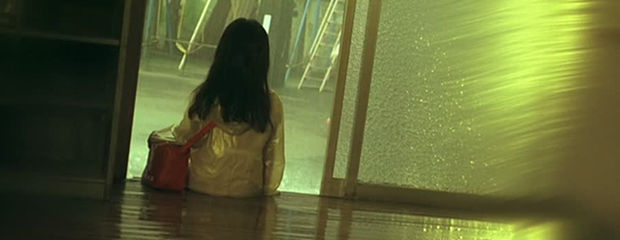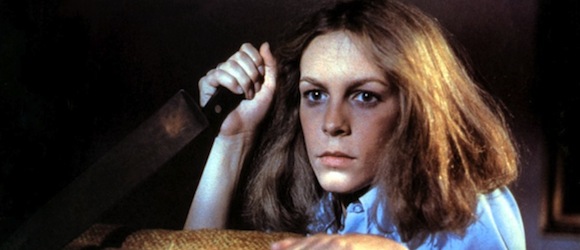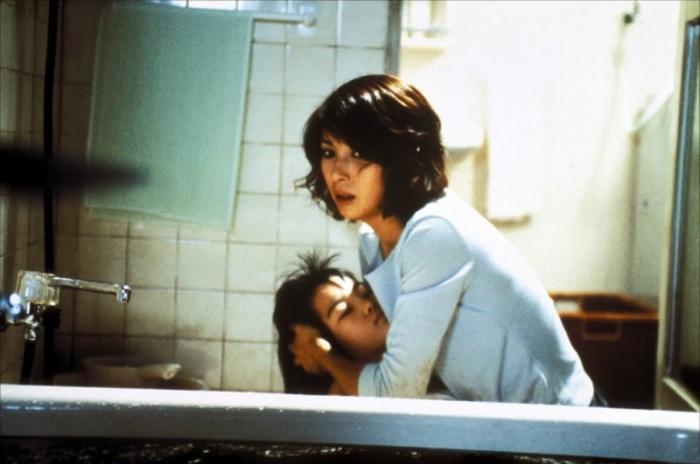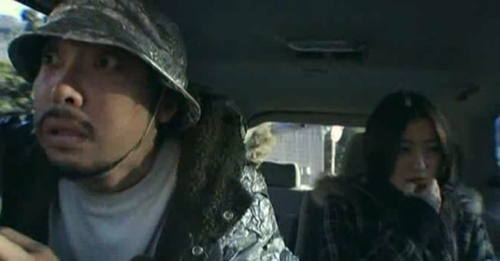
For the past two semesters I’ve taught an advanced English course that focuses on sci-fi and horror. At the beginning of both semesters, my students were almost completely unified in their tastes—they loved sci-fi but did not watch horror. Most of them used those exact words: “I don’t watch horror films.” Given that they’d grown up in the country that gave us The Ring and other horror classics, I was a little disappointed. But I assured them that the movies on my syllabus (Alien, Halloween, and Dark Water, among others), while certainly intense at times, didn’t include rape scenes and weren’t violent or gory on the level of Audition or the Saw franchise. This wasn’t squeamishness on my part, just a tendency to teach what I know (and an understanding that since the course is not for film students I shouldn’t expect them to sit through deeply disturbing films).
Next semester, though, I’m considering dropping the “horror” component altogether and just focusing on sci-fi. It breaks my heart, but the reviews are in—my students don’t like scary movies, and my course (so far) isn’t doing anything to change their minds. I don’t want to design courses based entirely on their likability factor, but it’s a little hard to teach a course when no one signs up for it, or when the students who DO sign up for it check out during the horror segments.
As a lifelong horror fan and more recent studious examiner of its meaning and significance in certain cultural / historical contexts, I forget that not everyone enjoys being terrified. I also have a certain amount of numbness when it comes to depictions of violence and gore on screen. This is partly the result of watching lots and lots of horror films, and it’s also a consequence of having worked in film and theater—it’s easy for me, in truly grotesque or horrifying scenes, to retreat into the knowledge that the blood is fake, that those are actors (or stunt people), and that no one is actually being flayed alive or dismembered before my eyes. This makes it difficult for me to recommend scary movies to newbies (which I’m often asked to do). I might think something is tame, but they likely won’t.
I also have to remind myself that my ability to love horror films stems, at least partly, from the fact that I’ve never experienced anything close to the kind of violence and terror that’s depicted on screen. Thus for me the horror movie experience is cathartic, not triggering. I can easily distance myself from what I see. Not so for plenty of other people who’ve actually experienced abuse or trauma.
I only have one or two close friends who actively seek out horror films. I tend to watch them alone or with my boyfriend, who doesn’t dislike them but isn’t as in love with the genre as I am. I often get asked why, why anyone would subject themselves to two hours of feeling constantly on edge or staring at grotesque and frightening images. My answer touches on a bit of Noel Carroll’s famous “Why Horror?” essay—horror films are cathartic. They allow us to experience the adrenaline of intense situations while we remain comfortably distant from them. Beyond that, I find the exploration of what scares us at different cultural and historical moments truly fascinating—the military, global pandemics, loneliness, domestic life, sex. Like all great art, I think horror films—both the cheap, exploitative ones and the high-end ones—offer a window into what it means to be a human being. On what society values and shuns, on what defines the masculine or the feminine (and how to break through those restrictive binaries).
I personally don’t know many other women who love horror films. Even though the characters, plot lines, and demographics have shifted a lot in the last two decades, most horror directors & writers are still men, and there’s still the assumption that these movies are made for men (or maybe couples on dates who want an excuse to grip each other in fear). Film Critic Jeffrey Wells recently wrote “Forget women seeing it” to describe the Leonardo DiCaprio survival-in-the-wilderness movie The Revenant, showing that the idea that women can’t handle scary or violent films persists (though he was savaged on Twitter for his comment).
Carol Clover’s Men, Women, and Chain Saws, which made a convincing argument that slasher films are a reflection of our very rigid ideas about gender and power, was written during a period when slasher movies were very much the domain of the teenage or college-age male. Clover also argued that the Final Girl, though sometimes held up as an empowering figure, was in fact a male fantasy and stand-in—the Final Girl was always masculine, never ‘girly,’ allowing the mostly-male audience to identify with her momentarily as she faced down the killer.

I’d argue that slasher films and horror films more generally have changed a lot since then—most contemporary slasher flicks have a meta-awareness (The Cabin in the Woods, the Scream franchise), there are horror movies with all-female casts who aren’t overtly sexualized (The Descent), and questions of sex and shame have become more complicated (the wonderful It Follows). That said, the gender stereotyping is still there. Though women play more dominant roles in the “found footage” genre that has gained popularity since The Blair Witch Project, the helpless, shrieking female character seems to have been replaced with another problematic character combo: the clueless / reckless guy + cautious / reasonable girl (on display in Cloverfield, Paranormal Activity, and Willow Creek).
There’s also the nagging issue of horror films’ penchant for fetishizing violence against women, and for having a narrowly objectifying gaze (plenty of female nudity, but no male). In Japan, where both the killers and the victims of J-horror films were often female, Hideo Nakata recently echoed a common sentiment: that we expect to see women in peril in a horror film because we know that they’re more physically fragile than men. Nakata goes on to say that women are also “more susceptible to ghosts and spirits, and they’re very sensitive to ambience.” While I’m loathe to give any credibility to the “women are naturally more protective and sensitive” stereotype, horror movies have certainly bought into it—as Carol Clover notes, it’s the female characters (especially the Final Girl) who usually realize that something isn’t right long before the male characters do. In slasher films, most of the victims are female, and it’s through the female characters that we experience the genuine terror of pursuit and escape (or defeat at the hands of the killer / monster). Unfortunately, this has led to a long and sordid history of women being creatively brutalized on camera, often with sexual violence or sexual subtext thrown into the mix.
Which leads me to J-horror, a genre I first encountered in Japan in the early 2000s. At its peak, J-horror offered non-Japanese film audiences a type of scare that seemed thrillingly new. For the most part, films like The Ring, The Grudge, Pulse, and Dark Water relied not on the excessive violence and gore that had come to dominate “torture porn” films like the Saw, Hostel, and Turistas franchises, but an atmosphere of slowly creeping dread, with effective use of sound, lighting, and framing to make the hairs stand up on the back of your neck with little effort. Jay McRoy wrote that these films also harkened back to U.S. horror films like Night of the Living Dead, when the ghosts and monsters were juxtaposed with themes like racism, the Vietnam War, and a general existential anxiety.
My fascination with Japanese horror grew out of a love for quiet, atmospherically creepy movies like The Haunting of Hill House, Rosemary’s Baby, and The Others (interesting that all those films share an “is it real or all in the character’s head” plot). J-horror films from the 1990s to the mid-2000s are varied in theme, and there were certainly plenty of scary Japanese films before the “boom” period, but quintessential J-horror for me will always be about the Thing That Lurks. Maybe it’s a ghost, maybe it’s an urge to do violence, maybe it’s just the fear of loneliness and isolation that so often plagues the protagonists. Like all great horror films, the best examples of J-horror are also windows into the fears and anxieties of a particular moment—the struggles of single parenthood, the awkward desire of teenagers, the alienation of children from their parents and those around them, the horrifying consequences of bullying.
Even some of the gore-fests were creative and risky. Takashi Miike’s Audition subverts the male killer / female victim trope by depicting a petite, ballerina-like young woman methodically torturing and dismembering her lover while using hyper-feminine, childlike language (saying, for example, kiri-kiri-kiri, roughly translating to “sticky-sticky-stick,” as she slowly stabs him with needles). This was one of the rare instances in which a female character didn’t need to man up before taking on the role of the aggressor—she remains utterly ‘girly’ throughout the film’s final act, making the violence she inflicts on the male protagonist all the more unsettling. Audition’s final scene isn’t shocking in the context of the horror genre, which is full of much more graphic depictions of bodily harm. It’s shocking because the sadist is a delicate woman that the film has spent its first half objectifying. Watching an endless series of creative torture and death scenes enacted by men doesn’t seem to elicit the same kind of rage and horror as Audition’s final scene, because the scene is a betrayal of convention—the girl is supposed to be knifed, not do the knifing herself.

By far the most affecting film of the bunch for me was Nakata’s Dark Water, which has a lot in common with The Ring (vengeful girl-child ghost, single mother, lots of water / drowning imagery), but which manages to pack a heftier emotional punch. Part of that is due to the limitations of Ringu’s lead actress, Nanako Matsushima, and the much stronger performance from Hitomi Kuroki (Rio Kanno also gives a convincing and occasionally heartbreaking performance as her young daughter). From its opening credits that seem filtered through murky water, Dark Water creates a potent sense of anxiety through the depiction of single mother Yoshimi trying to find a job and a decent place to live as she deals with a custody battle. Initially, evidence of ghostly goings-on in the new apartment just seems like one more annoyance to add to the list, and it doesn’t seem irrational to think that the problems might all be in her head. The ending doesn’t offer easy answers, and that’s part of the appeal.

As much as I loved many of the quintessential J-horror films, I’ve been mostly disappointed with the offerings of the last four or five years, which have tended toward self-parody and the casting of former and current pop idols in leading roles (Nakata’s latest, Ghost Theater, is a typical example). Takashi Miike’s 2014 Kuime recreated a genuinely eerie theater set that made me desperately want to see the play-within-the-film, but the film itself was muddled. Kiyoshi Kurosawa is mostly directing dramas these days, though his adaptation of the Yutaka Maekawa novel Kurīpī, slated for release in 2016, might be a return to the scary stuff. I did enjoy the rich visuals and shojo ai themes at the heart of Gekijōban zero, the film based on the wildly popular (and very scary) Fatal Frame video game, even if the parts didn’t quite add up to a satisfying whole.
There are also interesting things happening at the uber-independent level. Akio Nanki and Kosuke Kibe’s double bill of two short zombie films, Neet of the Dead and The Last Will, both use the idea of zombies to examine Japanese attitudes toward mental health, one with comedy and one with surprising poignancy. In Neet of the Dead, the zombie apocalypse is seen through the eyes of a typical middle-class Japanese family with a hikikomori (social shut-in) son. When they realize he’s become a zombie, the father’s first response is “How can you tell?” Ultimately, the film manages to convey a dark but strangely satisfying message about Japan’s very narrow definition of success, depicting an eerily familiar world in which everyone must literally eat others to survive.
Another zombie film, John Cairns’ Schoolgirl Apocalypse, peppers its story of a small-town zombie invasion with animated references to Japan’s notoriously stilted high school English language textbooks. Despite the sensational title, it’s actually a solid film that focuses more on the reality of a teenager losing everything she knows and loves and being forced to grow up too quickly. (Full disclosure: I know John Cairns personally.)
The films of Kōji Shiraishi are also an interesting mix—mostly found footage / mockumentary with elements of sly comedy and a keen eye for exactly what’s ludicrous about the Japanese entertainment industry. Shiraishi also directed the banned-in-the-UK splatter flick Grotesque (a film with enough rape and violence in the description to keep me from watching it), and his Cursed Violent People coasts along as a dark comedy until the deeply shocking and (somewhat) unexpected ending. Shiraishi seems to love playing with a horror film viewer’s tendency toward voyeurism. His films constantly ask us whether we should be watching what we’re watching, who filmed it and for what purpose, and how much we’re willing to tolerate as a viewer.

It would be easy to dismiss many of Shiraishi’s films as pure exploitation, especially Grotesque, but I can’t help thinking that there’s more going on. For one thing, he makes a point of scrutinizing the brutal, demeaning treatment that women often receive in both Japanese films and the film industry as a whole, depicting male “loser” characters who seem to bully women to mask their own weaknesses. He also has a very wry sense of humor and an insider’s eye for detail when it comes to the tropes and conventions of Japanese horror. Watching his films, I find myself shifting back and forth between laughter at the inside jokes, disgust at the bullying and violence inflicted on (mostly female) characters, and extreme uneasiness when the perpetrators of said violence are punished more horribly than I could have imagined.
With so many interesting things happening in the world of horror inside and outside Japan, it’s a shame that my students probably won’t see any horror films beyond the ones I show in class. True, horror isn’t everyone’s cup of tea, but it worries me that many of my students are so timid. They don’t just dislike horror films, they seem to dislike any media form that’s unsettling or dark. I despair of a generation of young adults who, beyond horror films, won’t watch anything that unnerves them, who are only interested in film as a form of happy ending escapism. Art that disturbs and unsettles can be a catalyst for change, or just a wake-up call to more closely examine concepts that we hadn’t thought about deeply before. Japanese horror has always done a good job of that. I hope there’s still a chance for another golden age.
Really enjoyed this article, long live Japanese horror!
LikeLike
Thanks JSebastian, new post coming soon on Sadako vs. Kayako and Kiyoshi Kurowsawa’s Kuriipi, soon to be released in Japan.
LikeLike